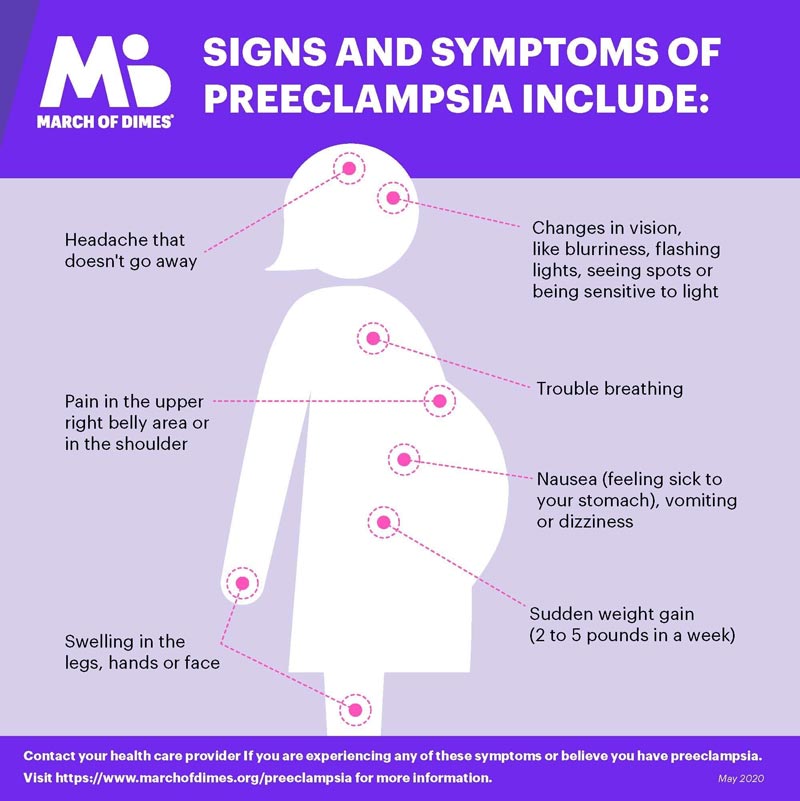This is called intra-uterine or foetal growth restriction. The patient is often the first responder.
The growing baby receives less oxygen and fewer nutrients than it should which can affect development.

What are the symptoms of preeclampsia. Mild cases of preeclampsia. Signs changes in measured blood pressure or physical findings and symptoms of preeclampsia can include. Women who have chronic hypertension have had preeclampsia in previous pregnancies or who have certain medical conditions such as lupus are at increased risk for developing preeclampsia.
Headaches Vision changes blurred vision seeing double seeing spots of light. While high blood pressure during pregnancy does not necessarily indicate preeclampsia it may be a sign of. Immediate treatment usually in a hospital is needed to stop the mothers seizures treat blood pressure levels that are too high and deliver the.
Preeclampsia is often precluded by gestational hypertension. Preeclampsia is a serious high blood pressure condition during pregnancy. Preeclampsia is a condition that occurs only during pregnancy.
The main sign of pre-eclampsia in the unborn baby is slow growth. Vision changes are one of the most serious symptoms of preeclampsia. Other symptoms of preeclampsia include protein in the urine headaches and blurred vision.
Severe cases of preeclampsia. A sudden rise in blood pressure above levels at the start of pregnancy proteinuria protein in your urine. High blood pressure water retention protein in the urine.
PRE-ECLAMPSIA Pre-eclampsia is a condition specific to pregnancy occurring after the 20th week of gestation characterised by hypertension proteinuria andor oedema. Over time you may also develop fluid retention oedema. Symptoms of Preeclampsia alongside high blood pressure Preeclampsia is a few cases that develop in the absence of any symptoms however there are a few things you can look for.
Knowing the symptoms of preeclampsia is vital especially for women at higher risk for the disorder. High blood pressure hypertension. Headaches blurred vision inability to tolerate bright light fatigue nauseavomiting urinating small amounts pain in the upper right abdomen shortness of breath.
If your blood pressure is 14090 or higher it may be time to become concerned. With greater understanding of the seriousness of preeclampsia comes greater compliance and reporting. Pre-eclampsia is a complication of pregnancy in which a pregnant woman has high blood pressure protein in urine and oedema and may develop other symptoms and problems.
If preeclampsia progresses to severe you may begin to notice other symptoms such as. Early symptoms of pre-eclampsia include. Take a look at the most common symptoms of preeclampsia.
The most telling sign is the presence of protein in the urine. Preeclampsia Signs and Symptoms In addition to swelling also called edema protein in the urine and high blood pressure preeclampsia symptoms include. Some symptoms may include high blood pressure and protein in the urine usually occurring after week 20 of pregnancy.
Weight gain over 1 or 2 days because of a. Early signs of pre-eclampsia include having high blood pressure hypertension and protein in your urine proteinuria. As the preeclampsia progresses the woman may experience fluid retention edema with swelling in the hands feet ankles and face.
Preeclampsia can be a rapidly progressing disorder with symptoms becoming more and more critical in a short window of time between regular prenatal appointments. One of these includes a sudden rise in blood pressure that is the most common and vital part of prenatal care. Eclampsia Treatment Eclampsiathe onset of seizures in a woman with preeclampsiais considered a medical emergency.
They may be associated with central nervous system irritation or be an indication of swelling of the brain cerebral edema. The symptoms of preeclampsia usually go away within 6 weeks of delivery. High blood pressure is one of the first signs youre developing preeclampsia.
Common vision changes include sensations of. Its unlikely that youll notice these signs but they should be picked up during your routine antenatal appointments. This is caused by poor blood supply through the placenta to the baby.

